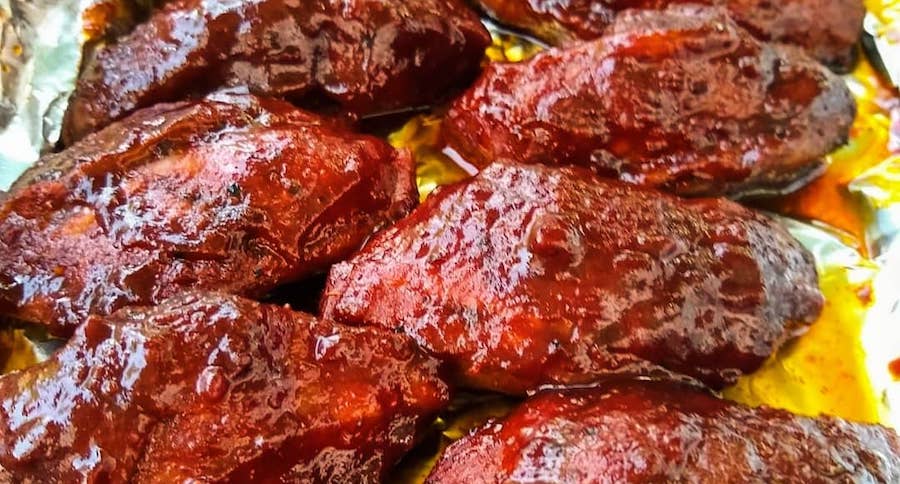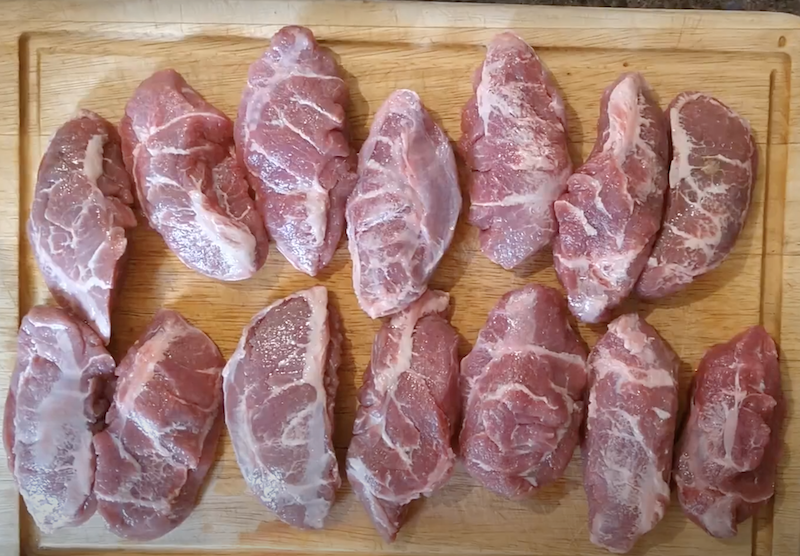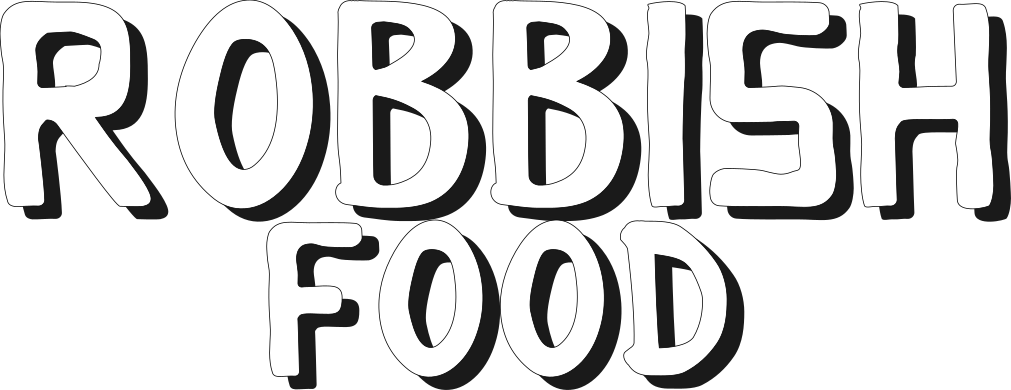How-to BBQ: Low-and-slow smoked pork cheeks

Cheeks always seem to be a great muscle, I probably said in my beef-cheek recipes that beef cheeks are one of my favourite cuts to cook, and pork cheeks are also a great option on the BBQ. They can be a little harder to get hold of (I haven’t seen them anywhere other than butchers) but they are super easy, really delicious and pretty quick.
Here are some reasons why you really need to start BBQing pork cheeks if you aren’t already:
-
They are cheap! Like most pork products, they are generally speaking cheaper than most other meats (chicken, lamb, beef) - and as an under-used cut of pork they are rarely in demand so usually pretty cheap (if they eventually get picked up by the hipster-gastro-pub folks expect prices to go up though!).
-
They cook pretty consistently - unlike other larger cuts, pork cheeks are going to be fairly consistently sized, so once you have a couple cooks under your belt you really don’t need to expect any surprises (compared to say beef brisket that can vary in timings by hours)
-
They are quick - pork cheeks can be pulled just like a pork shoulder can - you want a big helping of pulled pork for a family meal, you could cook a 2 kg pork shoulder all day and hope its ready in time, or you can grab 2 kg of pork cheek and have them cooked comfortably in 5 hours!
-
They are fun - I feel as though pork cheeks still have a novelty to them, and served up whole as little sweet, smokey nuggets of BBQ pork for guests is something a bit different.
You can see a couple of my BBQ pork cheek cooks over on my instagram, if you want to check out how good they look!
As usual, all my BBQ recipes will work equally well on a ceramic grill such as a Big Green Egg or Kamado Joe, a bullet smoker such as the Weber Smokey Mountain or a pellet grill such as Traeger or Broil King - no adaptation of the recipe or technique needs to change.
If you prefer, I also have a video walkthrough of the process of smoking pork cheeks, step-by-step here.
1. How to buy pork cheeks
As mentioned already, I have yet to see pork cheeks in supermarkets in the UK, so the only place you can get them is likely a decent butcher. You should (at current prices) be expecting not to be paying more than £10 a kilo for them, which is a good price.
You may get asked if you want the pig jowl, which is a bit more than you really want for BBQing pork cheek - the rest of the jowl can be used for all sorts of interesting things (Bath chaps, guanciale) but for BBQing we just want the little oval shaped muscle from the cheek. If you can, ask your butcher to just butcher those for you.
2. Preparing pork cheeks for cooking
2.1 Extracting the cheek muscle [OPTIONAL]
As noted above, sometimes the pork cheek muscle may come attached to the whole jowl - the muscle itself should just be a little oval shaped pink lump of meat, if it has a large fat cap or skin attached to it then you also have the jowl.
This is what we are after from the cheeks:

In this case, you simply want to extract that muscle from the rest of the jowl. This is really easy, carefully pry the muscle out with a sharp knife and it should give little resistance.
2.2 Apply dry rub
Normally, before I apply my dry rub, I will apply a layer of yellow mustard (French’s or Heinz) - this will just help the rub stick to the meat a bit better, the mustard flavour won’t be noticeable after cooking so you don’t need to worry about people not liking that taste.
Once the mustard is lightly smothered on, I apply a liberal dusting of the dry rub. This really should be quite a decent covering, so don’t be shy here. If you want to make your own rubs then there are lots of recipes and options you can do, but if you want to play it safe for the first cook then a pre-bought rub is probably a good option. Angus & Oink here in the UK make lots of great rubs, and for pork I’d highly recommend Pigasus, Sweet Butts & Bones or IRN BBQ!
3. How to smoke pork cheeks
The easiest way to smoke pork cheeks is to apply what we know about cooking pork ribs! They are relatively similar and not a huge difference in size (well, not really), and the technique works well.
With this in mind, my go-to approach for BBQing pork cheek is basically using the 3-2-1 method famous for smoking ribs. It involves smoking the cheeks for a while to get a good layer of that smokey flavour, before wrapping them and letting the humidity steam them a little to make them really tender, then finishing off opened up again and sauced a bit to get them nice and sticky and sweet.
Because the pork cheeks are smaller, individual cuts, for the final unwrapping step I generally tend to just open the top of the foil wrapping leaving the cheeks in a small foil boat with the cooking liquid. I usually find that a bit easier and allows continued basting and moisture.
As covered in my How to BBQ pork ribs recipe, below are the basics of the 3-2-1 technique:
3 - unwrapped cooking - The first step is to develop that classic BBQ smokey flavour, its only in the early stage that the meat takes on this flavour. If you cut this shorter then you risk loosing some of that flavour, but to be honest you should easily get a decent smoke flavour after just 2 hours.
2 - wrapped cooking - This step is to help tenderise the meat and speed up cooking. Wrapping in foil creates a much more humid cooking environment, which makes for a much more efficient transfer of energy - similar to how braising is a lot more energy efficient method of cooking. If you have time on your side you could reduce this, but likewise, if you are short on time, if you increase the time wrapped, the overall cook time will come down.
1 - unwrapped cooking - This final step is to dry out the bark a bit, and also for saucing them (if you are doing that).
So, knowing what each of the 3-2-1 phases achieve, we can adjust our cooking times based on what we need. If we are short on time, cooking the middle step for longer will reduce the overall cook time, but likewise if we are spoilt for time we can push through and cook unwrapped for longer (even the whole cook!).
4. How to check for “doneness”
Pork cheeks are pretty reliable, and honestly having cooked them a fair few times I’m pretty comfortable that in the time frame they are going to be fine. But, to test them the first thing is the probe - a temperature probe or fork should be able to probe a cheek with little resistance. As usual, we’d be expecting an internal temperature of around 96C/205F, but consistency wise we are aiming to be able to easily pull or shred the pork cheeks with a fork.
- 500grams - 1kg pork cheeks (depending on how many you are feeding)
- 10 minutes
- 5 hours
Ingredients
- Pork cheeks - as many as people you want to feed
- Yellow mustard (French's/Heinz)
- BBQ Rub (see notes for recommendations)
Directions
- Pork cheeks should take very little prep - they are small, fairly consistently sized muscles a bit smaller than your fist. It may be that your pork cheeks are still attached to the _jowl_ (e.g. a layer of fat and skin), we want to remove that muscle from the rest of the jowl (save it for use later)
- Apply a light coating of yellow mustard to the pork cheeks
- Liberally apply the BBQ rub on all sides of the cheeks
- Set up the BBQ for indirect cooking at 110C/225F, add a few pieces of wood and smoke the cheeks for 2 hours
- Remove the cheeks and wrap tightly in foil or butchers paper, there should be no moisture escaping from it (neither steam nor leaks) - you can add a little BBQ sauce or water to the foil wrap at this point too if you like
- Return to the BBQ and cook for 1 1/2 - 2 hours
- Open up the foil package and return to the grill to finish off uncovered. Apply some BBQ sauce and generally baste the cheeks with the moisture from the foil boat. The sauce should reduce to a sticky consistency during this stage. Cook for a final 30 - 60 minutes
- At this point the cheeks should easily probe and pull apart with a fork
- Serve as you like - either whole or pull them to make a pulled pork dish
More delicious recipes
This is one of the many fantastic recipes available on this blog
